The end of the fabulous era of the Maharajas marked the final phase of the DEMOCRATIZATION of Indian society. A throne may be an anachronism in a republic , but in bygone eras, it signified power and the thrones of Indian royalty had the rich patina of history.

At the same time , it is to be regretted that sufficient care has not been taken by the Govt of India to ensure that the vast array of State Regalia, especially the throne of over five hundred former Indian princes, are given the status of National Treasures. Incidentally, during their days of suzerainty in India, the British never allowed the Indian princes to use word ‘Thrones’ for the regal chairs from which they ruled. Only the Indo-Persian word of ‘GADDI‘, which meant the ‘nobel seat‘, was permitted, as in British-Indian protocol, only the King of GREAT BRITAIN ( who was also the Emperor of India), had the right to use the words ‘Thrones‘and ‘Royal. Further , by subduing in conquest Indian sovereigns like MAHARAJA DULEEP SINGH of the PUNJAB and TIPU SULTAN of MYSORE, the British ensured that the fabulous thrones of these opponents were taken to great Britain as war spoils.
PEACOCK THRONE
Of all Indian thrones, the most famous has been the PEACOCK THRONES of the MUGHAL EMPERORS, fabricated out of –
- 1150 kg of GOLD
- 230 kg of PRECIOUS STONES
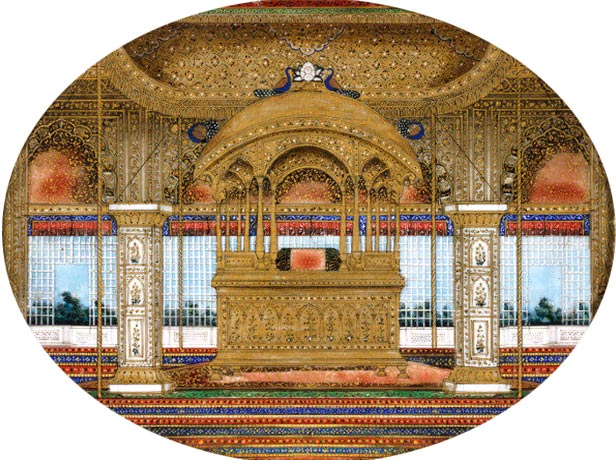
After his victory over the Mughals in 1739, NADIR SHAH , The Persian Emperor, took away this throne to his country and the throne was destroyed during the internecine wars that ravaged Persian after his death in 1747. It is thought that parts of the original Peacock Throne were used to form the throne on which the last SHAH of IRAN was coronated.

TIGER THRONE
Another famous throne of Indian history was the TIGER THRONE of TIPU SULTAN (1749-99), named for the two snarling tiger at its pedestal.
James Forbes in his book, ORIENTAL MEMOIRS Vol. 2, writes –
‘TIPU SULTAN’s proud boast was that he would rather live two days as a tiger that two hundred years as a sheep. He adopted as the emblem of his state and as a species of armorial bearings, the figure of the royal tiger, whose head and stripes constituted the chief ornaments of his throne and of almost every article which belonged to him. This throne was of considerable beauty and magnificence.
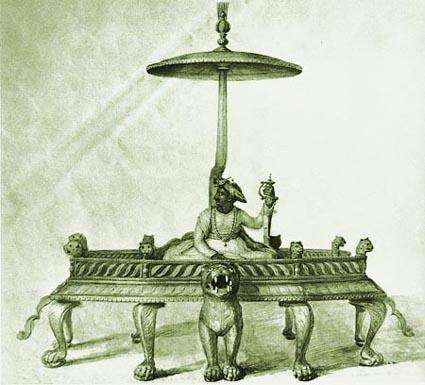
The support was a wooden tiger as large as life, covered with gold, in the attitude of standing. His head and forelegs appeared in front and under the throne, which was placed across his back. It was composed of –
- An octagonal frame,
- Eight ft by five ft,
- Surrounded by a low railing, on which precious stones were decorated,
- The heads of gold,
- Beautifully inlaid with precious stones,
- The ascent to the throne was by small silver steps on each side,
- From the centre of the back part, opposite the large tiger’s head ,
- Arose a gilded iron pillar, seven ft high,
- Surrounded by a canopy ,
- Superbly decorated with a fringe of pearls,
- Covered with a thick sheet of the purest gold,
- Richly illuminated with tiger stripes and Arabic verses,
- The Huma Bird, Persian symbol of prosperity , was placed at the top of the canopy and seemed to flutter over the Sultan’s head.
- The Huma Bird, It was about the size and shape of a pigeon. It is looked upon as a bird of happy omen and that every head it overshades will in time wear a crown.
- The tail of the Huma bird on TIPU’s Throne, its wing , were in the attitude of flying. It was formed of gold, entirely covered with Diamonds, Rubies and Emeralds.

This bird , the most beautiful and magnificent ornament of the throne, was sent by the MARQUIS of WELLESLY, the Governor General of India, to the Court of Directors. It was about the size and shape of a pigeon and intended to represent the fabulous bird of antiquity , well known to all Persian scholars , a bird peculiar to the East, supposed to fly constantly in the air and never to touch the ground. It is looked upon as a bird of happy omen and that every head it overshades will in time wear a crown. The tail of the Huma bird on TIPU’s Throne, its wing , were in the attitude of flying. It was formed of gold, entirely covered with Diamonds, Rubies and Emeralds. ‘

This fabulous throne was destroyed by the British Army Prize Agents in 1798, after the defeats of Tipu Sultan, so that the Gold sheets covering the throne could be distributed as prize money to the British Army. Few portions of this famous throne, including two of the tiger-face supports, are kept in the Powys Castle Museum in Great Britain . A few years after the destruction of the throne , a British artist drew from the destruction of the throne, with the gold Huma bird. Decades later , Prince GHULAM MUHAMMAD ( son of Tipu Sultan ), visiting Great Britain, confirmed that the real throne was more or less as depicted in the picture.
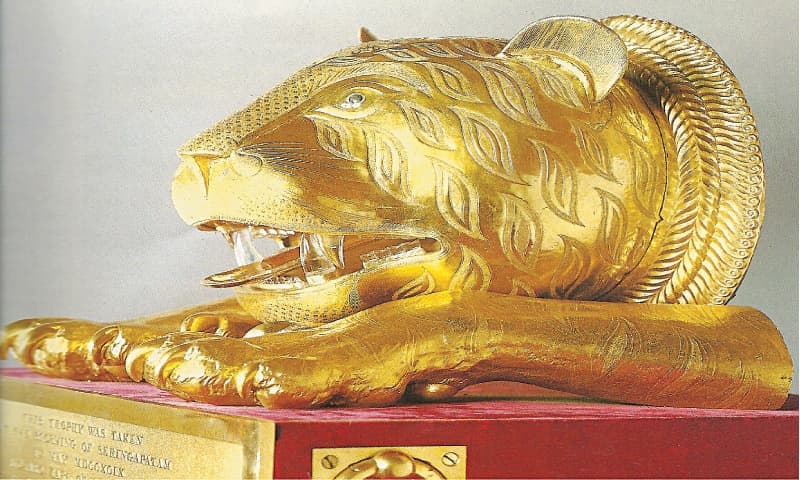
Maharaja Ranjit Singh’s Throne –
Another famous throne taken away by the British, the throne of MAHARAJA RANJIT SINGH, the last independent ruler of the PUNJAB, is kept today at the VICTORIA and ALBERT Museum in London.

( https://en.wikipedia.org/wiki/Maharaja_Ranjit_Singh%27s_throne )
To quote historian KHUSHWANT SINGH: ‘ In the correspondence on record is a letter dated December 19, 1850, from Lord Dalhousie to the Director of the EAST INDIAN COMPANY, asking whether they would be interested in acquiring the golden chair in which the BURRA MAHARAJA ( RANJIT SINGH ) held his court’. Apparently they were , and later gifted the throne to QUEEN VICTORIA.
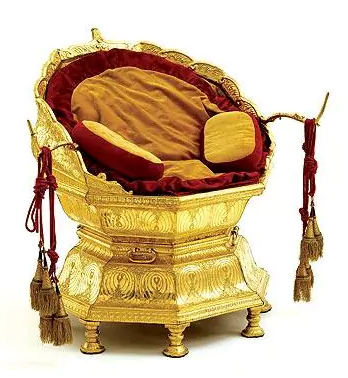
Throne shows the splendour of Ranjit Singh’s court and is decorated with –
- Richly worked sheets of gold.
- It was crafted by Hafez Muhammad Multani, a goldsmith.
- The distinctive cusped base of this throne is composed of two tiers of lotus petals.
- The lotus is a symbol of purity and creation and has traditionally been used as a seat or throne for Hindu gods.
The ultimate resting place of the throne of the great warrior-king , Shivaji , continues to intrigue historians. A few years ago, extension searches were made by the Central Archaeological Department of the Govt of India, at the Raigarh Fort in the state of Maharashtra , where Shivaji was crowned Chhatrapati ( Independent King ), free of Mughal suzerainty in 1674. Local legends aver that this famous throne weighting nearly 80 kg and encrusted with jewels, was thrown into the tank inside the Raigarh Fort, to prevent the Mughal forces ( who captured Shivaji’s son, Shambaji ) from taking it away. Despite pumping out the 50 ft deep tank, the Archaeological Department was unable to find the throne.
Of the throne still extant in India, the top place goes to the throne of the Pandavas ( the heroes of the MAHABHARAT ), now in the Palace-Museum at Mysore.
Vikramaditya –
Another historian refers to it as the historic throne of the Indian Emperor Vikramaditya ( after whom the Hindu era is named), lost for centuries and later rediscovered from an obscure cave by the equally famous Emperor Bhoja. After the death of this legendary monarch, the throne was lost to history.
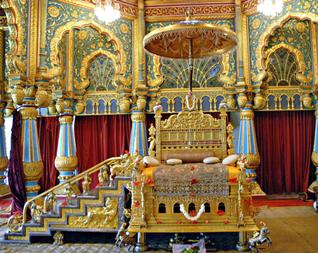
Vijayanagar –
In the 16th century AD, with the rise of the Vijayanagar Empire in South India, Guru Vidyaranya , the preceptor of the royal family, found this throne and used it as the coronation chair of the Vijayanagar Kings. The Vijayanagar Empire came to an end in 1565, and this throne passed on to the Mysore Maharajas in 1609. Another historian refer to it as the gift of Emperor Aurangzeb in the late 17th century, to the Kings of Mysore!
When the adventurer, Hyder Ali took over the reins of Mysore state 150 years later, he did not wish to use this throne with its Hindu pantheon representations. Following the defeat of Hyder Ali’s famous son, Tipu Sultan, The British discovered this throne in the lumber rooms of the palace at SRIRANGAPATNAM. For the last two centuries, this has been the coronation throne of the Maharajas of Mysore. Made of fig wood, it was originally covered with IVORY. Later , this IVORY casing was replaced with gold and silver panels, emblazoned with Hindu mythological figures.
NIZAM –
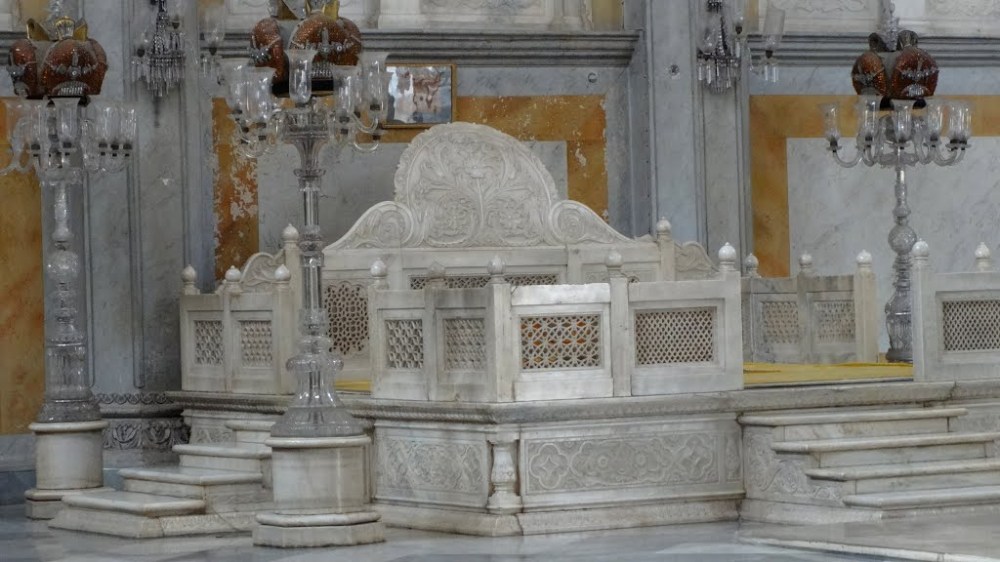
Surprisingly, the throne of the Nizam of Hyderabad, the richest of the Indian princes, is a simple affairs, carved out of plain white marble. Kept in an austere Durbar Hall in the Chowmohallah Palace at Hyderabad , it has yellow cushions and at each corner of the throne platform are clusters of yellow chandeliers shaped akin to the mitre-like headdress of the Nizams.
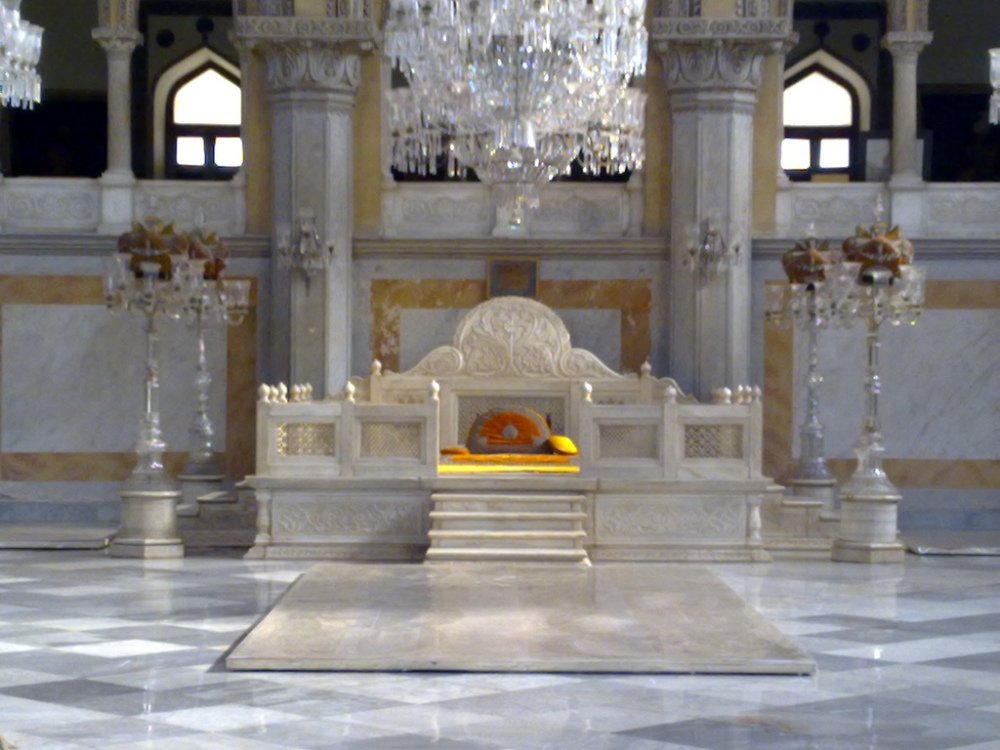
Travancore ( KERALA ) –
Travancore State in south India is famous for its IVORY thrones. A number of exquisitely carved ivory thrones were presented by the MAHARAJA of TRAVANCORE to the British Crown and are now in the royal collection. The famous INDOLOGIST, Stella Kramrisch, found a 200-year-old ivory throne in the RANGAVILASAM PALACE in TRIVANDRUM and describes it as covered with ivory slabs with exquisite designs carved into them , as if in FILIGREE. Due to the ravages of time, the ivory has begum to contract, creating gaps in the thrones.


Delhi Durbar of 1911 –
The British who ruled India for almost two hundred years, never brought their coronation thrones to the subcontinent. But during the Delhi Durbar of 1911 , a costly and serious problem faced the Govt of India – the necessity of providing a royal throne for the Emperor of India for the grand ceremony. It was suggested that the most economical course would be to cast a silver throne after the Durbar . It was felt that if a throne was made in the open market , a good deal of the cost could be recovered by selling it. But on paper, the cost of buying the throne would be regarded as sacrilegious to sell a throne, which had been used for such a grand ceremony purpose………….. Finally . a bright official decided that the ideal plan would be to allow the MINT to make the throne – the metal being classed simply as, ‘ HELD in reserve’. Nobody would then be able to object to the subsequent remelting of the throne.
The FINANCE MINISTER of the Govt of India found the proposal to be most integenious and ordered that the NINE TONS of SILVER LYING IDLE in the Mint, could be used and if more was required , it could be taken temporarily from the stock of withdrawn and non-current coin. The only reservation he expressed was that the silver throne would not be restored to the Mint and might be gifted away to the Victoria Memorial at CALCUTTA, then built as a MUSEUM for BRITISH ARCHIEVEMENTS in INDIA.
The VICEROY promised to help in preventing this historical throne from being gifted away to the VICTORIA MEMORIAL and then work began in real earnest , the famous CALCUTTA Jeweller’s firm of HAMILTON & COM. , being asked to cast the throne. Strangely enough, it was only at this stage that it was realized that actually two thrones had to be made as there was an Empress of India to be accommodated.

The final designs as approved, called for two thrones of solid silver ‘GILDED‘ all over. The Emperor’s throne was to weigh 510 kg and the Empress’s 360 kg. But is those halcyon days, the total cost of the 2 thrones as only Rs. 82,500. In 1991, the silver content alone would cost Rs. 7,000,000. Six new cushions were to be made for the thrones and pads for the footstools, upholstered in best quality silk, velvet and gold embroidered , with English gold bullion fringes these cost Rs. 1,750. Today, the same upholstery would cost over HALF A MILLION RUPEES.
In order to accommodate the heavy thrones, the Delhi Durbar Committee was ordered to ensure extra heavy platforms for the Durbar Hall to prevent accidents. After the Durbar, the thrones were kept for a long time in the VICEREGAL PALACE at SHIMLA for safe custody, as the thrones had been created out of Indian Revenue. It would have been ‘wrong’ to take the regal chairs out of India , and the VICEROY , a mere representative of the Emperor and his wife, could not be allowed to sit on the same throne. At this juncture, news leaked out in Govt circles that after the Durbar the thrones would be melted down. Many British people were desirous of possessing the historic thrones and offers came from interested parties. Some MAHARAJA offered to buy the thrones as well. But the Govt of India opined that as they had been used for the coronation of the Emperor of India, it was in the highest degree improbable that the Govt would entertain any proposal for the sale of these thrones. In 1963 after former VICEREGAL PALACE in SHIMLA was given to the EDUCATION DEPARTMENT of the Govt of India , to house as Institute of Humanities, these thrones were removed to the Govt of India MINT and later to the MUSEUM of RASHTRAPATI in New Delhi. Strangely enough, the same upright code of behavior did not apply to the special crowns made for the royal couple out of Indian revenues. These were blithely taken back to Great Britain as state Regalia.

The Viceroy and the Vicereine had their own thrones to preside over State occasions in India. The Emperor’s thrones, as well as the Viceregal chairs, are now kept in the special museum attached to RASHTRAPATI BHAVAN in New Delhi. Many smaller thrones owned by the former Indian princes have been melted down by them in order to secrete away the gold and silver. In this way priceless specimens of the Indian jeweller’s art, have been lost forever.
A few years ago , with their ‘owners’ running short of cash, the thrones of the former rulers of Nayagarh and Ranpore were advertised for sale in orissa. Fortunately, the state preserved them for posterity.
Great info 🙂
Thanks for creating this page 🙂
LikeLike